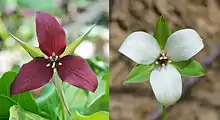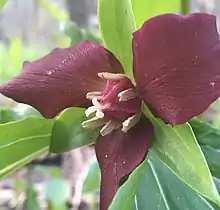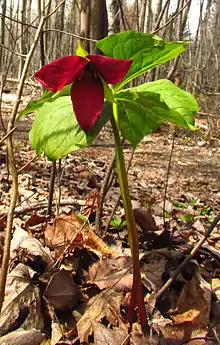Trillium erectum
Trillium erectum, the red trillium,[3] also known as wake robin,[4] purple trillium,[5] bethroot,[6] or stinking Benjamin.,[7] is a species of flowering plant in the family Melanthiaceae. The plant takes its common name "wake robin" by analogy with the European robin, which has a red breast heralding spring. Likewise Trillium erectum is a spring ephemeral whose life-cycle is synchronized with that of the forests in which it lives. It is native to the eastern United States[8] and eastern Canada from northern Georgia to Quebec and New Brunswick.[9]


| Trillium erectum | |
|---|---|
 | |
| Scientific classification | |
| Kingdom: | Plantae |
| Clade: | Tracheophytes |
| Clade: | Angiosperms |
| Clade: | Monocots |
| Order: | Liliales |
| Family: | Melanthiaceae |
| Genus: | Trillium |
| Species: | T. erectum |
| Binomial name | |
| Trillium erectum | |
| Synonyms[2] | |
|
Synonymy
| |
Description
Trillium erectum is a perennial herbaceous plant that grows to about 40 cm (16 in) in height with a spread of 30 cm (12 in). It can tolerate extreme cold in winter, surviving temperatures down to −35 °C (−31 °F).
Like all trilliums, its parts are in groups of three, with a 3-petalled flower above a whorl of pointed triple leaves.[10] The petals are usually dark reddish maroon to purplish, fading to purple with age, but petal color is variable with yellow, pale green, pink, or white petals occurring occasionally throughout the range of the species.[11] The ovary is dark purple to maroon regardless of petal color. The carrion-scented flowers attract scavenging flies for pollination. Eventually the flower petals wither, leaving behind a fruit that ripens to a dark red berry-like capsule, 1 to 1.5 centimeters long.[12][13]
Species Complex
Trillium erectum shares many anatomical details with other North American Trillium species.[14][15][16] These species hybridize in the wild, which has led some researchers to group them into a species complex, specifically, a syngameon of semispecies.[17][18]
The combinations of traits that are supposed to differentiate members of the complex from one another are sometimes inconsistently combined in wild populations. This has led some researchers to declare the individual species invalid, and refer to the species complex collectively as T. erectum (sensu lato).[19] Others acknowledge the existence of introgression and hybrid swarm formation between some or all complex members, but maintain that the named species within the complex represent convenient groups with common features.[20]
Members of the T. erectum complex have flowers with the following commonalities: (1) petals that are coarse and stiff in texture (in contrast with the wavy edges of other species), (2) petals that do not change color after pollination, (3) petals with prominent, netted veins, (4) fleshy stigmas that are attached to the ovary separately, without a common style, and (5) conspicuous, deeply-ridged ovaries.
North American members of the T. erectum species complex:
- T. cernuum
- T. erectum
- T. flexipes
- T. rugelii
- T. simile
- T. sulcatum
- T. vaseyi
The Asian species T. camschatcense, resembles the North American T. flexipes very closely, and itself has close relatives with similar floral features. However, trillium speciation in this group of Asian species is characterized by differences in chromosome number, with hybrids more definitively distinguishable from parent species by karyotype.
- T. apetalon
- T. camschatcense
- T. channellii
- T. × hagae
- T. smallii
- T. tschonoskii
Varieties
Two infraspecific names are accepted:
T. erectum var. album has white petals. All other petal colors (including yellow) constitute the nominate variety (var. erectum). Variety album occurs occasionally throughout the range of the species. At elevations less than 450 m (1,480 ft) in western North Carolina and other areas surrounding the Great Smoky Mountains, the white-flowered variety of T. erectum predominates.[23]
Cultivation
Trillium erectum is cultivated as a flowering ornamental plant. It has received the Award of Garden Merit from the Royal Horticultural Society.[24]
Medicinal uses
The root was traditionally used as an aid in childbirth, hence the name "Beth root" (a corruption of "birth root"). Native Americans used root tea for menstrual disorders, to induce childbirth, and to aid in labor.[6]
The leaves contain calcium oxalate crystals and crystal raphide, and should not be consumed by humans.
References
- "Trillium erectum". NatureServe Explorer. NatureServe. Retrieved 2008-05-02.
- Kew World Checklist of Selected Plant Families
- "Trillium erectum". Natural Resources Conservation Service PLANTS Database. USDA. Retrieved 15 December 2015.
- Case Jr., Frederick W. (2002). "Trillium erectum". In Flora of North America Editorial Committee (ed.). Flora of North America North of Mexico (FNA). 26. New York and Oxford – via eFloras.org, Missouri Botanical Garden, St. Louis, MO & Harvard University Herbaria, Cambridge, MA.
- Dickinson, T.; Metsger, D.; Bull, J.; & Dickinson, R. (2004) ROM Field Guide to Wildflowers of Ontario. Toronto:Royal Ontario Museum, p. 79.
- Pistrang, Mark. "Northern Red trillium (Trillium erectum L.)". United States Forest Service. Retrieved 1 July 2019.
- Stinking Benjamin: A trillium that by any other name would smell so sweet Archived 2011-12-10 at the Wayback Machine, adirondack almanack
- "Trillium erectum". County-level distribution map from the North American Plant Atlas (NAPA). Biota of North America Program (BONAP). 2014. Retrieved 3 October 2019.
- Case Jr., Frederick W. "Trillium erectum: distribution". Flora of North America. Retrieved 7 October 2019.
- RHS A-Z encyclopedia of garden plants. United Kingdom: Dorling Kindersley. 2008. p. 1136. ISBN 978-1405332965.
- Case Jr., Frederick W. (2002). "Trillium erectum var. erectum". In Flora of North America Editorial Committee (ed.). Flora of North America North of Mexico (FNA). 26. New York and Oxford – via eFloras.org, Missouri Botanical Garden, St. Louis, MO & Harvard University Herbaria, Cambridge, MA.
- "Purple Trillium (Trillium erectum)". Adirondacks Forever Wild. Retrieved 8 July 2019.
- Gros d'Aillon, F. "Trillium erectum Linnaeus". Retrieved 8 July 2019.
- Barksdale, Lane (1938). "The pedicellate species of Trillium found in the southern Appalachians". Journal of the Elisha Mitchell Scientific Society. 54 (2): 271–296. JSTOR 24332541.
- Case, Frederick W.; Case, Roberta B. (1997). Trilliums. Portland, Oregon: Timber Press. ISBN 0-88192-374-5.
- Patrick, Tom (2007). "Trilliums of Georgia". Tipularia. 22: 3–22.
- Millam, KC (2006). The Trillium erectum species-complex (Melanthiaceae): Insights from molecular systematics and biogeography (PhD). University of Wisconsin at Madison.
- Stoehrel, Christina Pampkin (November 2010). A study of the systematic relationships between members of the Trillium erectum complex (PDF) (MSc). Western Carolina University.
- Friesner, Ray C. (1929). "The genus Trillium in Indiana". Butler University Botanical Studies. 1: 29–40.
- Patrick, Thomas S. (1984). "Trillium sulcatum (Liliaceae), a new species of the southern Appalachians". Brittonia. 36 (1): 26–36. doi:10.2307/2806287. JSTOR 2806287. S2CID 85116255.
- "Trillium erectum var. album". Plants of the World Online. Royal Botanic Gardens, Kew. Retrieved 10 November 2019.
- "Trillium erectum var. erectum". Plants of the World Online. Royal Botanic Gardens, Kew. Retrieved 10 November 2019.
- Case Jr., Frederick W. (2002). "Trillium erectum var. album". In Flora of North America Editorial Committee (ed.). Flora of North America North of Mexico (FNA). 26. New York and Oxford – via eFloras.org, Missouri Botanical Garden, St. Louis, MO & Harvard University Herbaria, Cambridge, MA.
- "AGM Plants - Ornamental" (PDF). Royal Horticultural Society. November 2018. Retrieved 17 August 2019.
External links
| Wikimedia Commons has media related to Trillium erectum. |
